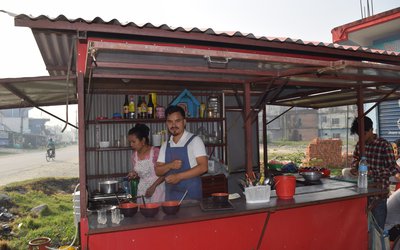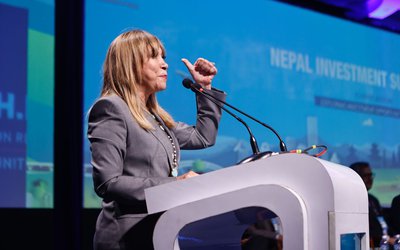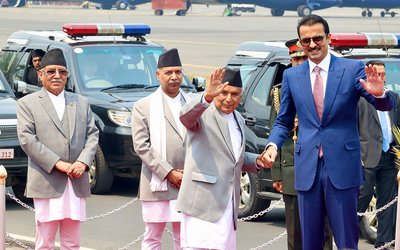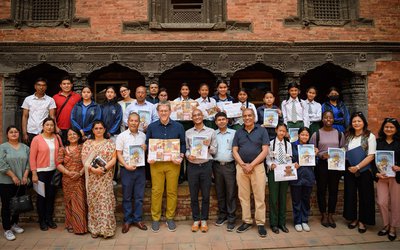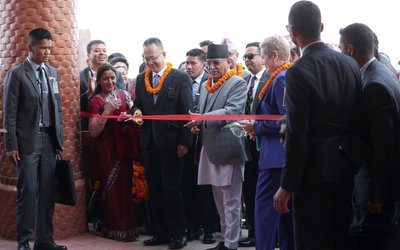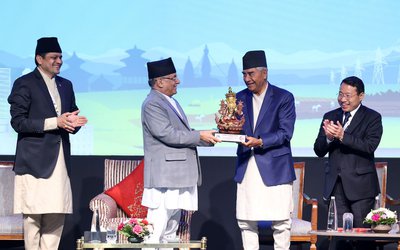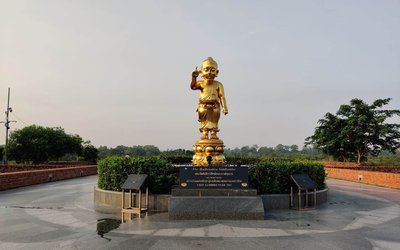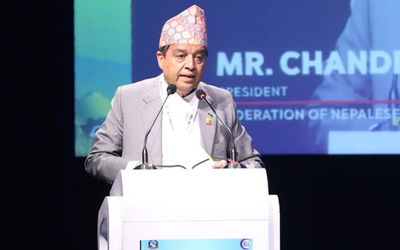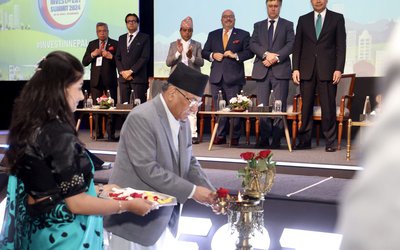China is now the second richest country in the world with annual GDP of about six trillion US dollars equivalent. Many western economists have already started to predict that in not distant future the Chinese economy leapfrogging at an average rate of over ten percent per annum could even overtake the USA. It is now speculated that the mounting debt ridden US Dollar, which was established as the world currency in place of the British Pound, might be replaced by the Chinese currency.
At present China is embarked on new plans to accelerate further economic developments by pushing back the frontiers of science and technology. In one of the recent BBC programmes on China it was said that the China has even overtaken the USA in publication of scientific papers. The ultimate aim of such vigorous Chinese science and technology efforts are sure to have been directed to country’s progress and prosperity through development based on full utilization of its natural resources. In this context the full scale exploitation of Tibet’s vast still untapped natural resources could have hardly been out of the sight of China’s highly skilled planners who are now going around the whole world in quest for opportunity to acquire the right to tap natural resources.
Tibet’s Accessibility
Exploitation of Tibet’s vast natural resources would provide an excellent opportunity for China’s rapid development but such task at locations in Tibet far away from country’s developed eastern coastal areas would not be easy . Fortunately the Tibet could be more readily accessible from the southern side, and such convenience in accessibility would allow for the vast natural resources of Tibet to be exploited with ease in a way to benefit China and also the countries in Indian sub-continent. In this context the proposed Kosi Navigation Canal could be expected to play an important role in establishing Nepal India China tripartite link for the purpose of exploitation of Tibet’s vast natural resources.
Kosi Canal Waterway
Nepal and India agreed in 1997 to conduct a detailed feasibility study for developing a navigable canal waterway extending from Chatra in Nepal to Kursella in Bihar, the meeting point of the Kosi River with the Ganges. The Kosi navigation canal will be linked to the National Waterway No.1 of India. The stretch of the waterway between Allahabad and Haldia has been declared the National Waterway No. 1 of India. The total length of this waterway is 1580 km. The National Waterway No.1 of India includes the Hoogly, Bhagirathi and the lower and middle reaches of the Ganges. This waterway can be broadly divided into three sections. They are the Haldia-Farakka, Farakka-Patna, and Patna-Allahabad sections, and the length of each of these sections is 500 km, 480 km, and 600 km respectively
On par with European Waterways
The use of the Kosi canal for navigation instead of the natural river course would allow the development of this very important waterway on par with the major waterways that exist in Europe and America. Some of the overwhelming advantages of the canal waterway linking Chatra with Kursella where Kosi merges with the Ganges are described hereinafter.
The distance would be short. The navigation canal would follow the shortest route to the Ganges river. The withdrawal of water from the river for irrigation or for other purposes would have to be significantly restricted, to maintain adequate depths if the natural river channel is to be used for navigation. In case of the navigation canal, the water required to maintain adequate depth would be very small. l The entry point of the Kosi navigation canal flowing into the Ganges is near the extreme tail end of this river and thus the Ganges river channel is sure to be quite deep at this stretch, allowing the operation of relatively large river vessels. Very big river vessels would be able to reach Chatra in Nepal if the Kosi canal waterway is also planned for operating vessels similar in capacity to those plying on the lowermost reach of the Ganges.
Cheapest Mode of Transport
The coefficient of friction on water is very small. One horsepower can pull 4,000 kg on water while on road and rail it can move only 150 kg and 500 kg respectively. In European and American countries, inland water transport has established itself as the cheapest mode of transportation. In USA, where various modes of transportation freely competing with one another are equally developed, inland water transport has been found to be 5 times cheaper than railway transportation and 21 times cheaper than road transportation.
USA had about 25,000 miles of internal commercial navigable channels in 1968, of which 15,000 miles provided operating depths of nine feet or more. The nine-foot draft is considered standard for barge and towing industry operations in the USA. About 490 million tons of freight was carried in 1968 by all kinds of river ships in USA.
According to a study conducted on behalf of the German State Railway, to move one ton of goods in Germany by one kilometer, it costs 14 pfenings by rail and 29 pfenings by road, but just 4 pfenings by inland waterway. It shows that inland water transportation is the cheapest by comparison with other modes of transportation.
Safety in Transit
Apart from being a very cheap mode of transportation, inland water transportation is the safest and the most reliable form of transportation with very little risks of pilferage, loss and damage of goods particularly in transit. Such a type of transportation is very convenient for moving goods and equipments that are very big and heavy. There are other inherent advantages of inland water transportation. Some of them are listed below:
( i) Ability to open market for otherwise non-marketable commodities
(ii) Stimulates industrial production.
(iii) Ability to attract production facilities to water-oriented locations in the interiors and thereby aid in their dispersal from the coastal congested areas.
(iv) Ability to fit services into production line processes for movement of raw materials.
At present China is embarked on new plans to accelerate further economic developments by pushing back the frontiers of science and technology. In one of the recent BBC programmes on China it was said that the China has even overtaken the USA in publication of scientific papers. The ultimate aim of such vigorous Chinese science and technology efforts are sure to have been directed to country’s progress and prosperity through development based on full utilization of its natural resources. In this context the full scale exploitation of Tibet’s vast still untapped natural resources could have hardly been out of the sight of China’s highly skilled planners who are now going around the whole world in quest for opportunity to acquire the right to tap natural resources.
Tibet’s Accessibility
Exploitation of Tibet’s vast natural resources would provide an excellent opportunity for China’s rapid development but such task at locations in Tibet far away from country’s developed eastern coastal areas would not be easy . Fortunately the Tibet could be more readily accessible from the southern side, and such convenience in accessibility would allow for the vast natural resources of Tibet to be exploited with ease in a way to benefit China and also the countries in Indian sub-continent. In this context the proposed Kosi Navigation Canal could be expected to play an important role in establishing Nepal India China tripartite link for the purpose of exploitation of Tibet’s vast natural resources.
Kosi Canal Waterway
Nepal and India agreed in 1997 to conduct a detailed feasibility study for developing a navigable canal waterway extending from Chatra in Nepal to Kursella in Bihar, the meeting point of the Kosi River with the Ganges. The Kosi navigation canal will be linked to the National Waterway No.1 of India. The stretch of the waterway between Allahabad and Haldia has been declared the National Waterway No. 1 of India. The total length of this waterway is 1580 km. The National Waterway No.1 of India includes the Hoogly, Bhagirathi and the lower and middle reaches of the Ganges. This waterway can be broadly divided into three sections. They are the Haldia-Farakka, Farakka-Patna, and Patna-Allahabad sections, and the length of each of these sections is 500 km, 480 km, and 600 km respectively
On par with European Waterways
The use of the Kosi canal for navigation instead of the natural river course would allow the development of this very important waterway on par with the major waterways that exist in Europe and America. Some of the overwhelming advantages of the canal waterway linking Chatra with Kursella where Kosi merges with the Ganges are described hereinafter.
The distance would be short. The navigation canal would follow the shortest route to the Ganges river. The withdrawal of water from the river for irrigation or for other purposes would have to be significantly restricted, to maintain adequate depths if the natural river channel is to be used for navigation. In case of the navigation canal, the water required to maintain adequate depth would be very small. l The entry point of the Kosi navigation canal flowing into the Ganges is near the extreme tail end of this river and thus the Ganges river channel is sure to be quite deep at this stretch, allowing the operation of relatively large river vessels. Very big river vessels would be able to reach Chatra in Nepal if the Kosi canal waterway is also planned for operating vessels similar in capacity to those plying on the lowermost reach of the Ganges.
Cheapest Mode of Transport
The coefficient of friction on water is very small. One horsepower can pull 4,000 kg on water while on road and rail it can move only 150 kg and 500 kg respectively. In European and American countries, inland water transport has established itself as the cheapest mode of transportation. In USA, where various modes of transportation freely competing with one another are equally developed, inland water transport has been found to be 5 times cheaper than railway transportation and 21 times cheaper than road transportation.
USA had about 25,000 miles of internal commercial navigable channels in 1968, of which 15,000 miles provided operating depths of nine feet or more. The nine-foot draft is considered standard for barge and towing industry operations in the USA. About 490 million tons of freight was carried in 1968 by all kinds of river ships in USA.
According to a study conducted on behalf of the German State Railway, to move one ton of goods in Germany by one kilometer, it costs 14 pfenings by rail and 29 pfenings by road, but just 4 pfenings by inland waterway. It shows that inland water transportation is the cheapest by comparison with other modes of transportation.
Safety in Transit
Apart from being a very cheap mode of transportation, inland water transportation is the safest and the most reliable form of transportation with very little risks of pilferage, loss and damage of goods particularly in transit. Such a type of transportation is very convenient for moving goods and equipments that are very big and heavy. There are other inherent advantages of inland water transportation. Some of them are listed below:
( i) Ability to open market for otherwise non-marketable commodities
(ii) Stimulates industrial production.
(iii) Ability to attract production facilities to water-oriented locations in the interiors and thereby aid in their dispersal from the coastal congested areas.
(iv) Ability to fit services into production line processes for movement of raw materials.
- QATAR AMIR’S STATE VISIT: Five Agreements
- Apr 28, 2024
- TANAHU HYDROPOWER PROEJCT: A Significant Achievement
- Apr 15, 2024
- AMBASSADOR HANAN GODAR: Sharing Pain With A Nepali Family
- Mar 30, 2024
- VISIT OF KfW AND EIB TO NEPAL : Mission Matters
- Mar 25, 2024
- NEPAL BRITAIN SOCIETY: Pratima Pande's Leadership
- Mar 24, 2024

